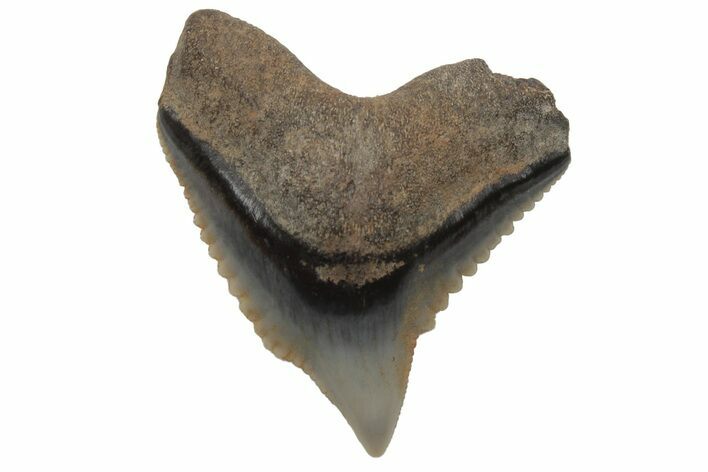This Specimen has been sold.
1" Fossil Tiger Shark (Galeocerdo) Symphyseal Tooth
This is a rare symphyseal tooth from an extinct tiger shark (Galeocerdo aduncus). It has great preservation and comes from the Hawthorn Formation of the southeastern United States, probably Georgia or South Carolina.
Comes with a small acrylic case.
Comes with a small acrylic case.
About Galeocerdo (Genus) Sharks
Galeocerdo, which means "fox shark," is the genus of all tiger sharks and tiger-like sharks, both living and extinct. Tiger sharks are a genus of requiem sharks (migratory, warm sea, live-bearing sharks) that have hunted the temperate and tropical seas since the Eocene epoch. These fearsome predators are nomadic and often live solitary lives, joining other sharks only for procreation. Tiger sharks are sometimes referred to as "garbage sharks": this refers to their disposition towards eating anything in their path.
The earliest Galeocerdo species in the fossil record is G. latidens from the Eocene. The more common fossils that come out of the American southeast are of G. aduncus, from the Oligocene, and G. cuvier, which originated in the Pliocene and persists today as the only living species of tiger shark.
The best way to identify Galeocerdo teeth by species is to look at the size of the tooth and the complexity of the serrations. Generally, larger teeth with more complex serrations point to a shark from a time closer to the present. For example, a tooth from G. cuvier is much bigger and more serrated than a tooth from G. aduncus or G. latidens.
Galeocerdo, which means "fox shark," is the genus of all tiger sharks and tiger-like sharks, both living and extinct. Tiger sharks are a genus of requiem sharks (migratory, warm sea, live-bearing sharks) that have hunted the temperate and tropical seas since the Eocene epoch. These fearsome predators are nomadic and often live solitary lives, joining other sharks only for procreation. Tiger sharks are sometimes referred to as "garbage sharks": this refers to their disposition towards eating anything in their path.
The earliest Galeocerdo species in the fossil record is G. latidens from the Eocene. The more common fossils that come out of the American southeast are of G. aduncus, from the Oligocene, and G. cuvier, which originated in the Pliocene and persists today as the only living species of tiger shark.
The best way to identify Galeocerdo teeth by species is to look at the size of the tooth and the complexity of the serrations. Generally, larger teeth with more complex serrations point to a shark from a time closer to the present. For example, a tooth from G. cuvier is much bigger and more serrated than a tooth from G. aduncus or G. latidens.
SPECIES
Galeocerdo aduncus
AGE
LOCATION
SE United States
FORMATION
Hawthorn Formation
SIZE
1" long
CATEGORY
SUB CATEGORY
ITEM
#212045
We guarantee the authenticity of all of our specimens.
 Reviews
Reviews












